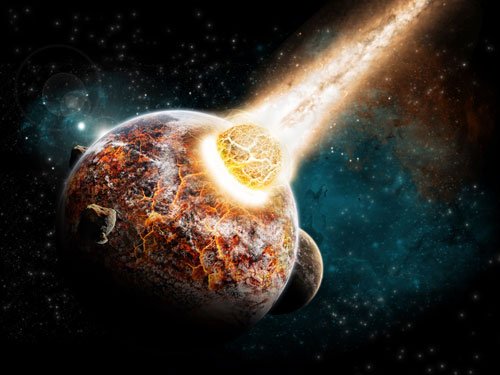THE ORIGIN AND DIVERSITY OF LIFE
Several theories concerned with the origin of life have been propounded.
Some of the major theories accounting for the origin of life on earth are:-
Special creation
Spontaneous generation
Steady- state
Cosmozoan and
Biochemical evolution.
SPECIAL CREATION
Many cultures have mythical account of a supernatural creation of life. Christianity provides the account of supernatural creation in the book of Genesis, chapter 1 verses 1-26 contained in the Holy Bible. Here, it is said that on the third day of creation, God brought forth-living creatures first plants, then fishes and birds, then land animals and finally man. Archbishop Ussher of Armagh calculated in 1650 AD that God created the world in October 4004 BC, beginning on October 1st and finishing with man at 9.00am of October 23rd. He arrived at his figures by adding up the ages of all the people in the biblical genealogies from Adam to Christ. His calculation has since been proved wrong because archaeological evidence suggests that there was already a well established urban civilization in the middle east at the time Adam lived.
The biblical account of creation has continued to generate controversy. There are differences of interpretation concerning the length of the "day" mentioned. in Genesis. The theologians, for example the English Jesuit John Turberville Needham, argued that "Genesis tells us, not that God created plants and animals directly, but that He badeth earth and waters to bring them forth". They believed that this directive has continued to be carried out. But while science relies on observation and experiment to seek truth, theology draws insight from divine revelation. Since the process of special creation occurred only once and therefore couldn't be observed, it is sufficient to put the concept of Special creation outside the framework of scientific investigation.
SPONTANEOUS GENERATION
This theory. credited to Aristotle (3844-322BC), says that life arises regularly from the non-living things: worms from mud, maggots from decaying meat, mice from refuse of various kinds. Aristotle's hypothesis of spontaneous generation assumed that certain "particles" of matter contained an 'active principle’ which could produce livmg organisms when conditions were suitable.
In 1688 Francesco Redi. an ltalian biologist and physician, strongly questioned the theory of spontaneous generation. He showed that maggots never developed In the meat that has not been exposed to flies. He developed the concept of biogenesis which supports the idea that life can arise only from pre-cxisting life. Also Louis Pasteur in 1860 showed that a nutritive broth which has been boiled (sterilized) and sealed away from contact with air did not grow microorganisms. He demonstrated the existence of bacteria. He showed that bacteria were ubiquitous and that non-living matter could easily become contaminated by living matter, if all materials were not adequately sterilized.
George Wald in 1954 suggested that the hypothesis of spontaneous generation might still be valid. He argued that what has been disproved of spontaneous generation is the belief that living organisms arose spontaneously under the present conditions. He believed that organisms might have arisen spontaneously under different conditions in some former period that no longer exists.
STEADYSTATE THEORY
This theory asserts that the Earth had no origin, has always been able to support life, has changed remarkably little, if at all and that species had no origin. This view is supported by the improved scientific dating techniques, which have given increasing ages for the earth, and extrapolation of this trend provides supporters of this theory with the hypothesis that the earth had no origin.
This theory proposes that species, too, never originated, they have always existed and that in the history of a species the only alternatives are for its numbers to vary, or for it to become extinct.
COSMOZOAN THEORY
This theory does not constitute a theory of origin as such because it favours the idea that life could have had an extra-terrestrial origin. The alternative name of this theory is the theory of pansperrnia. It states that life could have arisen once or several times in various parts of our Galaxy or the universe.
The background evidence for this theory includes the sighting of unidentified flying objects (UFO), cave drawings of rocket-like objects and 'spacemen' and reports of encounters with aliens. Research into materials from meteorites and comets have revealed the presence of many organic molecules, such as cyanogens and hydrocyanic acid, which may have acted as "seeds" falling on a barren Earth. There are several claims that objects bearing resemblance to primitive forms of life on Earth have been found in meteorites and in 1996 NASA scientists in the USA identified what they thought could be the remains of bacteria-like organisms in a rock from Mars.
BIOCHEMICAL EVOLUTION
In the 19303, Alexander I. Oparin, a Russian biochemist pointed out that the primitive Earth must have had a reducing rather than an oxidizing atmosphere made mostly of hydrogen, methane, ammonia, nitrogen and water. He thought that oxides of carbon, nitrogen and other element were probably present; but molecular oxygen was scarce. Developing an argument that was presented by J .B.S Haldane 1n 1929, Operin proposed that the energy of ultraviolet light and lightning discharges could have turned the gasses in the hypothesis,‘reducing atmosphere into a "primordial soup" of organic molecules. The molecules soon accumulated in the oceans as a "dilute soup".
Based on present day knowledge it is thought that life may have evolved through the following steps:
Synthesis of organic monomer molecules such as amino acids nitrogenous‘bases and sugars.
Formation of organic polymers such as proteins and nucleic acids and
Isolation of polymers.

.jpg)
.jpg)

.jpg)